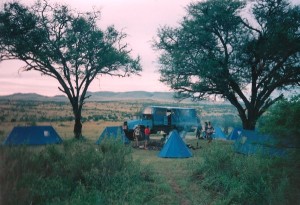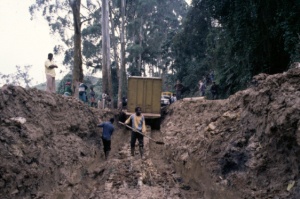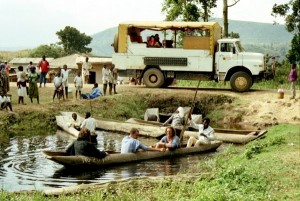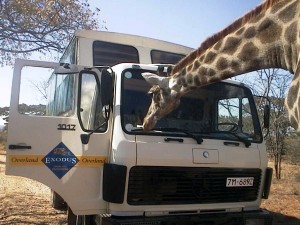 It was hard to decide if it was the pothole’s size, the water in it, or the queue of traffic on the opposite side that presented the biggest problem. There was no alternative route, it was either forward, or backtrack 500km at an average speed of 35km/hour. There were 20 of us, we were young, most were reasonably fit, we had washing up bowls, pots and motivation – surely it wouldn’t take too long to empty the water & mud out of the hole. Pothole is perhaps the wrong description, but what else do you call a 40m long, 3 meter deep hole situated in the middle of the road?
It was hard to decide if it was the pothole’s size, the water in it, or the queue of traffic on the opposite side that presented the biggest problem. There was no alternative route, it was either forward, or backtrack 500km at an average speed of 35km/hour. There were 20 of us, we were young, most were reasonably fit, we had washing up bowls, pots and motivation – surely it wouldn’t take too long to empty the water & mud out of the hole. Pothole is perhaps the wrong description, but what else do you call a 40m long, 3 meter deep hole situated in the middle of the road?
 A few hours later the hole was emptied and we, the paying passengers, happily formed a human barricade against the local two-wheel drive trucks that so desperately wanted and needed to get into the hole first so that our trustee 4×415/168 MAN could pull them out the other side.
A few hours later the hole was emptied and we, the paying passengers, happily formed a human barricade against the local two-wheel drive trucks that so desperately wanted and needed to get into the hole first so that our trustee 4×415/168 MAN could pull them out the other side.
 Overlanding has changed a lot since the first Bedford drove down from London to Zimbabwe in the mid 70s and so have the vehicles. In the old days newly built, but second hand, Overland trucks were driven from London to Kenya with a group of up to 20 clients. The tour price was cheap for the client and the Overland companies didn’t have to pay to ship the trucks into East and Southern Africa – shorter trips grossed more profits and everyone was happy!
Overlanding has changed a lot since the first Bedford drove down from London to Zimbabwe in the mid 70s and so have the vehicles. In the old days newly built, but second hand, Overland trucks were driven from London to Kenya with a group of up to 20 clients. The tour price was cheap for the client and the Overland companies didn’t have to pay to ship the trucks into East and Southern Africa – shorter trips grossed more profits and everyone was happy!
Old German army square nose MANs, Mercedes (mainly 1017s), English Dafs, Scanias (1992 & 1993 vintage), Leylands & the trusted Bedfords travelled up and down Africa taking clients to various ‘highlights’ en route.
 The Overland concept was simple. Take a group of relatively like minded people, who have limited money but lots of time, put up to 20 of them in a converted truck and take them around Africa. The trucks were designed with coach seats or benches, carried t
The Overland concept was simple. Take a group of relatively like minded people, who have limited money but lots of time, put up to 20 of them in a converted truck and take them around Africa. The trucks were designed with coach seats or benches, carried t ents, stools, fire grates, water, long range fuel tanks, fridges, cool boxes, fully equipped kitchens & stereos. The self participatory trips meant that clients took turns in food shopping, cooking & cleaning the truck. Trips ranged from 4 to 22 weeks – vehicles broke down, coups and route changes meant Post Restantes weren’t reached, empty bottles were traded for onions, pineapples & chi
ents, stools, fire grates, water, long range fuel tanks, fridges, cool boxes, fully equipped kitchens & stereos. The self participatory trips meant that clients took turns in food shopping, cooking & cleaning the truck. Trips ranged from 4 to 22 weeks – vehicles broke down, coups and route changes meant Post Restantes weren’t reached, empty bottles were traded for onions, pineapples & chi ckens & food intolerances were unheard off!
ckens & food intolerances were unheard off!
Overlanding has always focused on low environmental impact, participatory travel in East and Southern Africa. European and African companies offer trips to suit a variety of budgets, they include most of the same places of interest but offer different types of accommodation, catering and vehicles.
 It is still possible to do a 12 week Kenya to Cape Town trip but the shorter sections of this classic route are proving more popular. Camping & self catering mean that visiting the Gorillas, Tanzania’s Serengeti and Ngorongoro Crater, the Masai Mara, Nakuru and other Kenyan National Parks becomes an affordable option for many. Clients leave the trucks in Dar Es Salaam to take the ferry across to Zanzibar to go diving, eat wonderful seafood, explore the historical Stone town, relax on its beaches and maybe do a spice tour. Then comes Lake Malawi with its stunning beaches & water sports. Zambia boasts South Luangwa and Kafue National Parks and Victoria Falls. At the Falls, trucks merge & clients have the opportunity to travel either through Zimbabwe to Hwange, Matopos, Antelope Park & Great Zimbabwe before visiting Mozambique’s beaches, Kruger National Park & finally Johannesburg. Alternatively they can reach Jo-burg via a seven day trip to Chobe National Park and the Okavango Delta in Botswana. The Namibia route takes them through Etosha National Park, down the skeleton Coast, past rock paintings to Fish River Canyon, the Orange River and finally Cape Town.
It is still possible to do a 12 week Kenya to Cape Town trip but the shorter sections of this classic route are proving more popular. Camping & self catering mean that visiting the Gorillas, Tanzania’s Serengeti and Ngorongoro Crater, the Masai Mara, Nakuru and other Kenyan National Parks becomes an affordable option for many. Clients leave the trucks in Dar Es Salaam to take the ferry across to Zanzibar to go diving, eat wonderful seafood, explore the historical Stone town, relax on its beaches and maybe do a spice tour. Then comes Lake Malawi with its stunning beaches & water sports. Zambia boasts South Luangwa and Kafue National Parks and Victoria Falls. At the Falls, trucks merge & clients have the opportunity to travel either through Zimbabwe to Hwange, Matopos, Antelope Park & Great Zimbabwe before visiting Mozambique’s beaches, Kruger National Park & finally Johannesburg. Alternatively they can reach Jo-burg via a seven day trip to Chobe National Park and the Okavango Delta in Botswana. The Namibia route takes them through Etosha National Park, down the skeleton Coast, past rock paintings to Fish River Canyon, the Orange River and finally Cape Town.
 Over the years the trips have become shorter to accommodate clients’ time constraints & expectations. Mobile phones & Email have taken over from Post Restantes, cooks are provided as a matter of course, trucks have solid sides, tinted windows, seat belts, iPod charging stations & a tight itinerary. Gone are the days of open roofed trucks, no public liability insurance and flexible schedules. Trucks need to be less than 10 years old in order to be imported into some of the African countries, and right hand drive is essential. The crew need mobile phones and the clients get fed feta cheese, fillet steak and other gourmet foods that weren’t available in most African countries a couple of decades ago!
Over the years the trips have become shorter to accommodate clients’ time constraints & expectations. Mobile phones & Email have taken over from Post Restantes, cooks are provided as a matter of course, trucks have solid sides, tinted windows, seat belts, iPod charging stations & a tight itinerary. Gone are the days of open roofed trucks, no public liability insurance and flexible schedules. Trucks need to be less than 10 years old in order to be imported into some of the African countries, and right hand drive is essential. The crew need mobile phones and the clients get fed feta cheese, fillet steak and other gourmet foods that weren’t available in most African countries a couple of decades ago!
 The new fleet of overland vehicles are nearly all 4×2 MAN M2000, Merc 1820 6: 1823, Scania 94 & the new ‘off the shelf’ lsuzu’s, Mitsubishi Fuso & MAN M2000, which are all purpose built for the overland industry. There’s less demand for 4x4s, but they still come into their own on specific contracts, like remote & sandy Botswana, or any trips that involve the Western Corridor of the Serengeti in the rainy season.
The new fleet of overland vehicles are nearly all 4×2 MAN M2000, Merc 1820 6: 1823, Scania 94 & the new ‘off the shelf’ lsuzu’s, Mitsubishi Fuso & MAN M2000, which are all purpose built for the overland industry. There’s less demand for 4x4s, but they still come into their own on specific contracts, like remote & sandy Botswana, or any trips that involve the Western Corridor of the Serengeti in the rainy season.
The trucks are newer, the clients expectations are higher (not quite as ‘rough & ready’ as in the old days), but the concept, adventure, routes and places still makes Overlanding a truly special travel experience.
